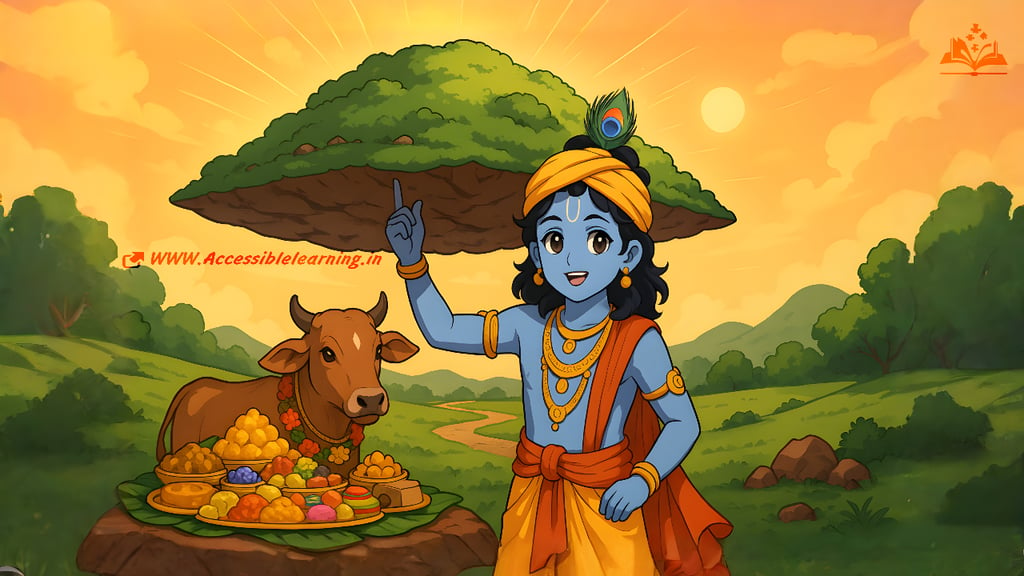
Govardhan Puja: Significance, Story, Rituals & Celebrations
Discover the spiritual significance, rituals, and cultural celebrations of Govardhan Puja 2025 (Annakut). Learn why Krishna Ji lifted Govardhan Hill and how devotees honor nature with Annakut offerings, cow worship, and regional traditions. A complete guide to Govardhan Puja’s story, importance, and modern-day relevance.
CULTURE/TRADITIONINDIA/BHARATCELEBRATION/FESTIVALS
Keshav Jha
10/18/20253 min read


Govardhan Puja, also known as Annakut Puja, is one of the most important Hindu festivals celebrated the day after Diwali. This sacred festival holds deep spiritual meaning, cultural heritage, and community bonding, especially in the states of Uttar Pradesh, Bihar, Haryana, Punjab, Rajasthan, and Gujarat.
Rooted in the devotion to Krishna Ji, Govardhan Puja symbolizes the victory of faith and humility over arrogance and false pride. It also highlights the importance of respecting nature, protecting the environment, and living in harmony with Mother Earth.
When is Govardhan Puja 2025?
Govardhan Puja is observed on the Pratipada Tithi of Kartik month (Shukla Paksha), which usually falls a day after Diwali/Deepavali.
In 2025, Govardhan Puja will be celebrated on 23rd October, Thursday (date may slightly vary by region and lunar calendar).
The Legend of Govardhan Puja: Why is it Celebrated?
The origin of Govardhan Puja is found in Srimad Bhagavad Gita and Puranic texts. According to Hindu mythology:
Once, the people of Vrindavan used to worship Indra Ji, the God of Rain, for timely showers and prosperity.
Krishna Ji, as a young boy, questioned this practice and advised villagers to instead worship Govardhan Hill, the real provider of fertile soil, food, water, and shelter.
Angered, Indra Ji sent torrential rains to punish the villagers.
To protect them, Krishna lifted the Govardhan Hill on his little finger and gave shelter to all under it for seven days and seven nights.
Finally, Indra realized his mistake and bowed to Krishna’s divine power.
Thus, Govardhan Puja is celebrated to honor Krishna’s protection, the power of nature, and gratitude towards resources that sustain life.
Rituals of Govardhan Puja
The rituals of Govardhan Puja vary across India, but some key traditions include:
1. Govardhan Parvat Symbol
Devotees create a small replica of Govardhan Hill using cow dung, clay, or soil.
The symbolic hill is decorated with flowers, food items, and incense.
2. Annakut (Mountain of Food)
Families prepare a wide variety of 56 bhogs (Chappan Bhog) or more dishes, sweets, and delicacies.
These offerings are made to Lord Krishna as a gesture of gratitude for nourishment and abundance.
3. Govardhan Puja Vidhi
The ritual begins with a prayer to Krishna Ji and Govardhan Hill.
Devotees perform aarti and offer food, fruits, and sweets to the deity.
Circumambulation (parikrama) of the Govardhan symbol is done for blessings.
4. Cow Worship (Gau Puja)
Since cows played a major role in Krishna’s life, Gau Puja is also performed.
Cows are bathed, decorated with flowers, and worshipped as a symbol of prosperity and divinity.

Regional Celebrations of Govardhan Puja
Mathura & Vrindavan (Uttar Pradesh)
The most grand celebrations occur in Braj Bhoomi, where Krishna spent his childhood. Devotees perform Govardhan Parikrama around the real Govardhan Hill. Lakhs of pilgrims gather here for kirtans, bhajans, and Annakut offerings.
Gujarat & Rajasthan
The day is also celebrated as Annakut Utsav in temples, especially in Vaishnav traditions like Swaminarayan temples.
Maharashtra
Govardhan Puja is observed alongside Bali Pratipada, marking the victory of Vishnu Ji over demon king Bali.
Punjab & Haryana
The festival is known as Vishwakarma Day, where workers worship their tools, machines, and agricultural instruments.
Spiritual Significance of Govardhan Puja
Devotion over Ego: Krishna’s act symbolizes humility and devotion as superior to arrogance.
Nature’s Respect: It emphasizes worshipping natural elements like hills, rivers, and animals.
Sustainability Lesson: Reminds us to value food, land, and environment, aligning with modern ecological awareness.
Community Bonding: Sharing food and performing rituals together builds unity and cultural identity.
Modern-Day Relevance of Govardhan Puja
In today’s world, Govardhan Puja is not just about mythology but also about environmental awareness. It teaches us to:
Respect Mother Earth and its resources.
Live sustainably and avoid over-exploitation of nature.
Strengthen community values through togetherness and gratitude.
FAQs
Q1: Are Govardhan Puja and Annakut the same?
Yes, Govardhan Puja is also called Annakut Puja, where a mountain of food is offered to Krishna Ji.
Q2: Can non-Vaishnav communities celebrate Govardhan Puja?
Yes, the festival is widely celebrated across different Hindu communities with regional variations.
Q3: Why is cow worship done on Govardhan Puja?
Because cows are sacred in Hindu culture and are considered part of Krishna’s divine play in Vrindavan.
Govardhan Puja is a festival of devotion, gratitude, and ecological awareness. Rooted in Krishna’s divine act of lifting Govardhan Hill, it reminds humanity of the importance of faith, humility, and respect for nature.
Whether celebrated through Annakut feasts, Govardhan parikrama, or cow worship, the spirit of this festival lies in acknowledging the gifts of nature and the divine protection of Krishna ji.
As we celebrate Govardhan Puja 2025, let us remember that protecting nature is the truest worship of Govardhan.
Subscribe to our newsletter
All © Copyright reserved by Accessible-Learning
| Terms & Conditions
Knowledge is power. Learn with Us. 📚


